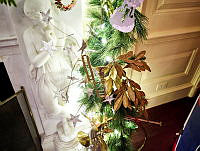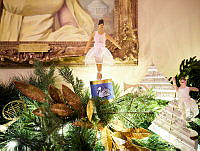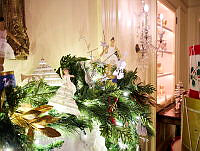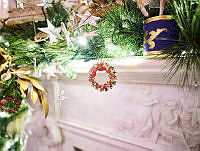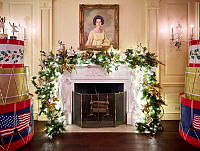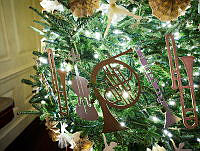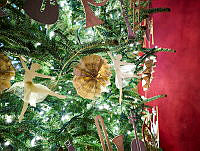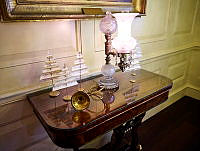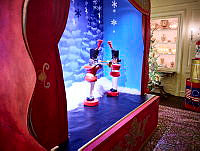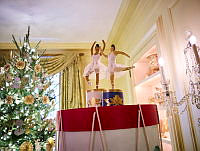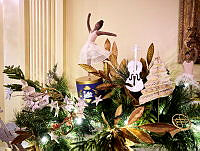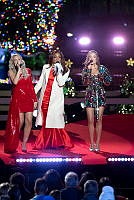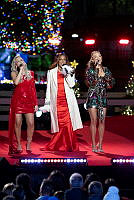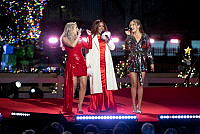Ford's Theatre and the White House
Copyright © Fall 2011 White House Historical Association. All rights reserved under international copyright conventions. No part of this article may be reproduced or utilized in any form or by any means, electronic or mechanical, including photocopying, recording, or by any information storage and retrieval system, without permission in writing from the publisher. Requests for reprint permissions should be addressed to books@whha.org
The histories of the White House and of Ford’s Theatre are obviously linked by their association with Abraham Lincoln. Their histories conjoined on the spring evening of April 14, 1865, when a popular comedy of the day became a tragic backdrop for a horrific real-life drama of national intrigue and violence. However, they are similar in another way: their respective images in the American mind have transcended their actual existence. In reality, neither structure survives intact. Both have been reconstructed within their original architectural shells to serve as memorials and symbols of a national heritage and history. Walt Whitman, observing the White House in the moonlight on February 24, 1863, described it as “full of reality, full of Illusion.”1 Certainly, after successive fires, remodelings, and reconstructions, the interior, at least, of the physical White House of the eighteenth, nineteenth, and first half of the twentieth centuries is no more. So, too, with Ford’s Theatre. Wholesale removal of interiors, physical collapse, reconstruction, and restoration have preserved the historical image that time has erased.
To understand the relationship of the White House and Ford’s Theatre beyond semiotic concepts of memorialization, it is necessary to look at the physical context of the two structures in Civil War Washington. By 1865, Washington’s theater district consisted of at least twelve halls and auditoriums relatively near the Executive Mansion. They offered fares and productions that varied from minstrel shows and men’s club frolics at the Clarendon and Metropolitan Halls to legitimate theater venues such as Willard’s Hall and Grover’s New Theatre (the National Theatre), where Lincoln’s son Tad attended a performance of Aladdin; or, The Wonderful Lamp the night his father was killed.2

A portrait of Tad Lincoln, the youngest child of President and Mrs. Lincoln.
National ArchivesFord’s Theatre was a respectable venue just blocks from the White House, in a converted Baptist church. In 1861 and 1862, George Christy had operated his minstrel troupe there. Between February 28 and March 19, 1862, the theater was remodeled and reopened as Ford’s Athenaeum by John T. Ford, a theater manager from Baltimore. Like many other entrepreneurs, Ford anticipated profit in a crowded wartime capital hungry for entertainment. The remodeling was somewhat hurried, as Ford was trying to beat out the opening of Grover’s New Theatre, and he did so. Yet he did not spare expenses when it came to promotion. Even before his remodeling, on his first playbill, November 19, 1861, Ford advertised the appearance of Miss Carlotta Patti, a celebrated opera diva of the day, in her first performance in Washington. Tickets were $1, and a Patti photographic book, 25 cents.3
The Athenaeum burned in December 1862. With plans by James J. Gifford, the theater was rebuilt and opened in August 1863 as “The New Ford’s Theatre.” Its Italianate brick facade was substantial but architecturally unremarkable, dominated by an arcade of five arches on the first floor and a large gable in the center of the upper story with a series of ventilators on the roof, the largest of these located at the front of the roof line. According to at least one set of surviving drawings, the new facade had been planned for more elaborate treatment in neoclassical mode, including a rusticated first story stone facade, six columns spanning the areas between the second and third stories, and decorative brackets and statuary for the top of the center pediment as well as both ends of the roofline. This further decoration was, however, never realized.4

The exterior of Ford’s Theatre, 1865.
Library of CongressLocated on Tenth Street between E and F Streets, Ford's Theatre was flanked by bars, restaurants, and similar commercial houses. These included both the Star Saloon, a sram shop adjacent to the theater that would play a significant role in the Lincoln assassination, and the Greenback Saloon. Lincoln's coachman, Francis Burke, and his miscreant bodyguard, John F. Parker, as well as his murderer, John Wilkes Booth, all had drinks at the Star the night of Lincoln's assassination. James P. Ferguson, owner of the Greenback Saloon that flanked Ford's on the opposite side, witnessed the assassination from the audience. As with many neighborhoods in Civil War Washington, contemporary photographs show the street as unpaved, littered, and poorly lighted. One account noted a large gas lamp in front of the theater,with the remainder of the street lighted by tar torches in barrels placed along the right-of-ways, smoking heavily as hucksters called out to advertise the evening's dramatic fare at Ford's.5
The new Ford's Theatre was a state-of-the-art facility. The house (advertised at 2,500 seats) presented a traditional theater layout of the day with a deep stage and paired box seating stacked on the north and south ends of the stage. The interior was opulent, executed by local craftsmen in whites, golds, reds, and greens, with wallpapers, draperies, and furniture in the “French” style. It gave the impression of tufted, overstuffed, and overdraped Victorian elegance, the popular decoration of the day that Mark Twain later described as “dreariness, flimsiness and bad taste reduced to mathematical completeness.” On the south or stage right, the state or presidential box (a combination of boxes 7 and 8) was located on the second, or “dress circle,” level adjacent to a hallway leading out to a service area. This box, in addition to ceremonial bunting, was hung in yellow satin draperies and Nottingham lace curtains.6
Lincoln had always been a fan of the theater, and Ford’s, one of the newest venues in town, was a favorite of the president. Between March 1862 and April 1865, Lincoln attended many plays there.
Lincoln had always been a fan of the theater, and Ford’s, one of the newest venues in town, was a favorite of the president. Between March 1862 and April 1865, Lincoln attended many plays there. A performance of The Marble Heart, in November 1863, starred John Wilkes Booth. The theater hosted all the major performers of the day, including the Shakespearean actors Edwin Forrest, Junius Booth Jr., Edwin Booth, and, of course, the celebrated British-born actress and promoter Laura Keene, who would play the lead in the comedic play Our American Cousin the evening of Lincoln’s assassination. A year before his death Lincoln had also attended a Treasury Department ball and reception at Ford’s. Lincoln and the first lady arrived at the theater by carriage, possibly the barouche that Whitman remembered seeing them riding in on other occasions in Washington.7
The well-known American comedian Joseph Jefferson III recalled that Lincoln, as a young attorney, had represented his father, an itinerant theater manager and owner, in Springfield, Illinois, before the Civil War. As a member of Laura Keene's theatrical troupe, Jefferson was famous for his portrayal of the leader character in Rip Van Winkle, and less so for his portrayal of Asa Trenchard in Our American Cousin. He was out of the country in April, 1865, and the actor Harry Hawk played the Trenchard role the night of the assassination. Jefferson had known Booth well in his youth and was greatly disturbed upon learning that he had killed Lincoln.8
Our American Cousin, by Tom Taylor, had first been produced by Keene’s troupe in 1858, and it guaranteed the fame of both Jefferson and Keene. The plot was predictable: a young Yankee man becomes enamored of an English dairymaid and, in an act of chivalry, destroys his uncle’s will that makes the youth his heir but disinherits the girl. It was during the comic line “you sockodoligizing old mantrap!” and the ensuing audience laughter that Booth chose to fire his fatal shot.

The assassination of President Lincoln as illustrated in publications of the day. This print, showing John Wilkes Booth's leap from the box was less familiar, but also printed for a public hungry for illustration of the event.
Library of CongressFamiliar with the layout of Ford’s Theatre, Booth was well enough known there to have the theater owner’s son pick up his mail and deliver it to him when he showed up at the theater the morning of the assassination to make various preparations. That evening, Booth left his horse with the stagehand Ned Spangler in the north alley behind Ford’s with instructions to hold the mount there as the horse was skittish. Spangler gave the duty to Joseph “Peanut John” Burroughs, an African American youngster and another Ford’s Theatre employee. Going inside, Booth tried to cross behind the scenery, but the performance was using the entire stage and the set was too deep for him to pass unnoticed. Instead, he slipped through a trapdoor and proceeded under the stage, coming up in the walkway known as Baptist Alley between Ford’s and the Star Saloon. He proceeded down the alley to Tenth Street, had a drink at the Star Saloon, and left.9
Entering the theater about 10:00 p.m., Booth climbed the lobby stairs to the second floor, proceeded along the west wall and then east to the seating area where Lincoln’s valet-messenger, Charles Forbes, was seated. Booth handed Forbes something; Forbes allowed Booth to pass through the door into the area outside the presidential box; there was no guard. At approximately 10:30 p.m., Booth forced his way through the door, shot the president in the head, stabbed the president’s guest Major Henry rathbone in the arm, and dramatically leaped from the box onto the stage. His spur caught in a draped flag, and he limped across the stage on a broken leg shouting “Sic semper tyrannis” (Thus always to tyrants) before a thunderstruck audience and cast. The line was taken from Shakespeare’s Brutus as he assassinated Julius Caesar; it was also the motto of Virginia. Booth hobbled to the alley, grabbed his horse from the astonished Burroughs, and rode away.10 Lincoln, fatally wounded, was carried across the street to the William A. Petersen House at the insistence of Peter Taltavull, owner of the Star, who allegedly remarked that it should not be able to be said of the president that he died in a saloon.11
Lincoln’s revered status as the president killed in the line of duty while preserving the nation was nearly immediate. Walt Whitman, who had described the White House as full of reality and illusion, himself contributed to Lincoln’s final national apotheosis with his poems “When Lilacs Last in the Dooryard Bloom’d” and “O Captain! My Captain!” long before the panegyrics of Carl Sandburg in the twentieth century. By 1922, when Daniel Chester French’s sculpture of the seated Lincoln (1920), in Zeus-like glory, was installed in the olympian temple on the National Mall, the murdered president’s portrait had joined that of George Washington on the walls of nearly every classroom in the nation. Lincoln, indeed, in the words of his secretary of war Edward M. Stanton, now “belongs to the ages.” According to an evolving national mythos, Lincoln’s ultimate sacrifice had finally welded a confederation of states into the federal vision of post–Civil War America. His death on Good Friday served only to further Christlike allusions of sacrifice and ultimate resurrection as the nation’s Great Emancipator—a classical echo of more ancient titles from earlier civilizations now cast in a democratic vein.12
George Washington’s portrait had graced the central portion of the bunting on the presidential box the night of Lincoln’s assassination. And as the nineteenth century ended and the twentieth century dawned, the images of both Washington and Lincoln, recast as the Father of the Country and the Son of the Republic, would be prime symbols of a new interpretation of the experience of the American West by Frederick Jackson Turner and others, providing the holy spirit of national identity grounded in place that bound the three images into a new American trinity as the United States reached its international majority at the dawn of the twentieth century.

This modern cut-away drawing shows Ford’s Theatre on the night of April 14, 1865. Akin to a movie, it illustrates the activity from the time President Abraham Lincoln was shot until he was carried across the street to Petersen House. The upper part of the view shows assassin John Wilkes Booth on the stage, having leaped from the presidential box, while the lower section takes the tragedy to the Petersen House, where Lincoln died.
National Park Service, artist Albert LorenzAs Michael W. Kauffman points out in American Brutus, the symbolic nature of the assassination and its classical allusions are obvious to the point of providing a rich exercise in psychohistorical evaluation. Detractors in both the North and the South and even in the U.S. Senate had compared Lincoln to an overreaching Caesar. John Wilkes Booth, son of Junius Brutus Booth, acted in productions of Julius Caesar with his brothers, Edwin and Junius Booth Jr., in the years before the assassination. His diary notation of April 15 as “the Ides,” plus his appropriation of the line attributed to Brutus—“Sic semper tyrannis”—underscored both his theatrical background and his vision of himself of a heroic defender of the republic who kills a Caesar-like president. His own naming after John Wilkes, a British revolutionary, his father’s middle name of Brutus, and his association with the classical play in which a national hero turned overreaching tyrant is sacrificed for the good of the republic all eerily echo the original classical allusions of the nation’s capital itself, where Maryland’s bucolic Goose Creek had been rechristened the Tiber and the design of official buildings took their cue from the monuments adorning Rome’s seven hills.
Booth would be hailed in the South as “Our Brutus,” his image printed on the front of sheet music and poems written to his memory. And like Caesar’s ghost, Lincoln’s corpse, subjected to the new art of embalming techniques applied at the White House, also became a macabre talisman of its own. The body made a national circuit for weeks by train and cortege, finally coming to rest in Springfield, Illinois. Attempts to steal the remains by criminals resulted in the entombment of Lincoln under tons of concrete at the order of his son, Robert Lincoln. And we can only wonder about the feelings of John Wilkes Booth’s brothers as they played Brutus and similar roles on the American stage in later years. In these cases, the symbolic often transcended grim reality. Those potent symbols continue to echo into our own day: Timothy McVeigh wore a T-shirt with Lincoln’s picture and the slogan “Sic semper tyrannis” as he detonated the federal building in Oklahoma City in 1995.13
Ford’s Theatre quickly became a site of infamy. The night of Lincoln’s
murder there were calls for it to be burned to the ground. It closed
immediately and was acquired the next year by the U.S. government, then
gutted and used for offices and storage, because use as a theater or for
any related amusement was out of the question. On June 9, 1893, the
building collapsed, destroying the back wall, killing twenty-two
government workers, and injuring many more.
14
Our collective national imagination causes the images of these buildings to continue to exist as important symbols and serve a purpose greater than that of a mere theater or residence.
By the 1930s, the old theater building was a Lincoln Museum. Interest in restoring it as “Ford’s Theatre,” continued to grow, and in 1968, the National Park Service supervised a reconstruction of the original theater interior based on historic documentation and photographs taken by the Washington photographer Mathew Brady; no original architectural drawings were available. It was opened as a theater and museum. In February 2009, the much-used theater was opened once again after an eighteen-month refurbishing with major contributions from American corporations including Exxon. President Barack Obama officiated at the ribbon cutting.15
As Joseph Campbell, scholar of myth and the human psyche, has noted, over time the symbolic often becomes more real than reality itself. Just as Lincoln is no longer physically with us, most of the physical past of Ford’s Theatre, like the original White House, is no more. Even the revered Lincoln birthplace, a log structure housed in a Beaux-Arts temple in Kentucky, is today known to be a reassembled fabrication. No conjurer’s trick or artistic manipulation can change these irrefutable realities, yet it is almost as if Lincoln’s countrymen expect him to return some day to one of his memorial sites. More important, our collective national imagination causes the images of these buildings to continue to exist as important symbols and serve a purpose greater than that of a mere theater or residence. Within their scarred walls lie the memories of the nation. Great care has been taken to honor their associations and to carefully replace their earlier realities with acceptable simulacra to inform our present lives. Ford’s Theatre, like the White House, lives on, not so much as physical reality but rather as an important national symbol in our collective American experience.
















